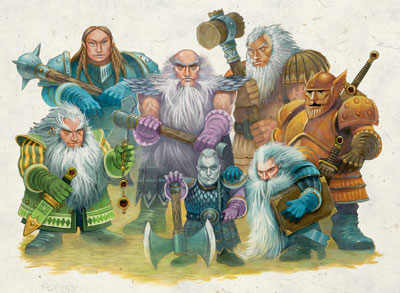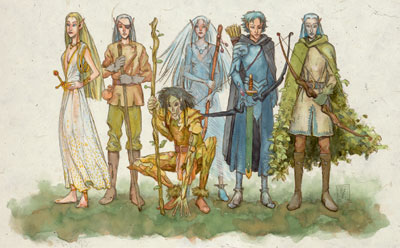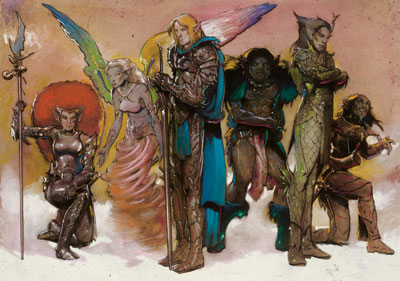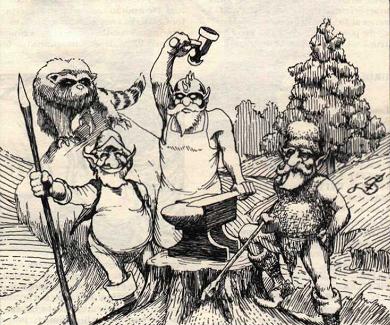
The material on the following 13 pages,
written by Roger E. Moore,
originally appeared in issues #58-63 of
DRAGON@
Magazine. It is reproduced
here as an adjunct to the “Non-Human
Deities” section of the DDG. <e>
Descriptions of certain major deities
mentioned in this text can be found in the DDG.
<e>
| Dwarven Pantheon | Elvish Pantheon | Gnomish Pantheon | Halfling Pantheon | Orcish Pantheon |
| Non-Human Deities | - | Deities & Demigods | - | Unearthed Arcana |


| Moradin | Clangeddin | Dumathoin | Abbathor | Vergadain |
| Berronar | Goibhnie | Hephaestus | - | Dwarves |
One of the most powerful of all the non-human
pantheons is that of
the dwarven fold, and it well reflects
their nature and beliefs as the human
pantheons reflect that of their human
worshipers. In describing
the dwarven pantheon, several distinct
differences are apparent between
it and usual human religions.
All of the greater dwarven gods are at
least twice as large as normal
dwarves, ranging up to Moradin’s 20-foot
height. Though some human
reviewers have said this is an indicator
of an inferiority complex
dwarves have about their height, this
claim is patently ridiculous.
More likely it reflects the dwarves’ own
sense of self-importance (perhaps
a little exaggerated, from the human viewpoint).
Dwarves refuse
to see themselves as a “minor race,” and
indeed, there is much to
support the view that the dwarves are
one of the most powerful of all
races (perhaps second only to humanity).
Lesser dwarven gods are generally shorter
than the greater gods; demigods are roughly normal dwarven height,
and no dwarven deity is taller than Moradin,
the Soul Forger.
Another interesting aspect of dwarven religion
is that the holy symbols
used are invariably not living objects:
tools, weapons, mountains,
minerals, and so forth. This derives in
large part from some of
the teachings of Moradin, who ruled that
the dwarves must hold no
other race above them; having an animal
as a symbol would then be a
way of saying that animal was better than
the dwarves. Likewise,
Moradin said that the dwarves should not
ever worship each other, so
no dwarf or part of one is used as a holy
symbol. Dwarves should take
pride in their accomplishments, and respect
the earth from which
they originally came; thus tools, weapons,
and similar items were developed
and used as religious symbols.
Five of the most commonly accepted dwarven
deities are described
in this text. A description of Moradin,
invariably the ruler of all dwarven
pantheons (though he may be known by several
different names)
is found in the DDG book. There
are many dwarven gods
and demigods, some of which may be connected
with certain planes
or areas all their own. Every clan of
dwarves has a pantheon that will
vary from every other clan’s pantheon
(leaving Dungeon Masters
quite free to develop their own pantheons
and not worry about anyone
else’s).
Some final notes about dwarven gods in
general: All dwarven gods
possess dual charismas, one applying to
dwarves and other dwarven
deities, and the other to everyone else.
Just as the dwarves hold
themselves as a race apart, so do the
dwarven deities generally keep
themselves aloof from the workings and
dealings of other pantheons
(with a few exceptions, as will be seen).
Most of the lesser deities and demigods
of the dwarves are connected
with the spheres of fighting and warfare,
guardianship, the
earth, metals, craftsmanship, volcanoes
and earthquakes, fire and
lava, the protection of the dead, medicine,
and strength. There are
very few or no deities known in dwarven
pantheons governing the
sea, the air and atmospheric phenomena
(rain, clouds, stars, etc.),
plant life and forests, comedy, animals,
and chaos.
Dwarves on rare occasions worship deities
from other pantheons. In
particular, Goibhnie
(of the Celtic mythos) and Hephaestus
(of the
Greek) draw much favorable attention from
dwarves, because they
represent powers of smith-work and the
earth.
* None of these dwarven gods
has a sacred animal.
Clangeddin is worshiped
on the battlefield, and the rest are worshiped in underground temples carved
from natural rock.
Only male dwarves may become
clerics of the male dwarven deities, and females become clerics of the
female ones.


| Corellon (CG) | Aerdrie (CGn) | Erevan (CN) | Hanali (CG) | Labelas (CG) |
| Rillifane (CG) | Solonor (CG) | - | - | Elves |
The elven pantheon is primarily located
on one of the planes of Olympus,
in an area known as Arvandor,
“The High Forest.” Here dwell a
large number of elven deities, who collectively
refer to themselves as
the Seldarine, which roughly translates
as “the fellowship of brothers
and sisters of the wood.” The title also
implies a wide diversity in capabilities
and areas of interests, linked together
by a desire for cooperation.
Though many of the beings’ areas of influence
overlap to
some degree, there is no conflict between,
them. Of all the Seldarine,
only Corellon Larethian is a greater god.
The Seldarine, almost without exception,
are chaotic, neutral, andlor
good in temperament. None are evil, and
a very few (two or three at
the most) are lawful. They act for the
most part independently of one
another, but are drawn together by love,
curiosity, friendship, to combine
their strengths to accomplish a task,
or by outside threats. Corel-
Ion Larethian, the most powerful of them,
reinforces this freedom of
action and compels none of them to perform
any task. Instead, they
seem to sense when something needs doing,
and automatically a few
of them (if more than one is needed) get
together and do it.
There are a number of interesting similarities
among the elven deities
and their religions. All the religions
practice tolerance for other religious
followings within the Seldarine, and for
a few religions of a
closely allied nature (the cult of Skerrit
the Forester being a prime example).
Most of these religions also emphasize
elven unity with life
and nature, and tend to blur the distinction
between elves and their
environment. Rillifane Rallathil, the
Leaflord, is at once a “giant ethereal
oak tree” and a “green-skinned elf clad
in bark armor.” Deep
Sashelas has a sea-green skin that mirrors
his habitat; Aerdrie
Faenya is usually depicted as deep blue
in color, like the sky she
rules. The weapons and tools and armor
used by these deities are often
regarded as merely extensions of the divinities,
sometimes as
true physical parts of them. The themes
of nature and magical power
also appear very frequently in tales of
elven mythology and religion.
Elven deities, when appearing in elven
form, are usually between 4‘
and 8‘ tall, with a few exceptions at
either end of the scale. Many of
these deities are also capable of assuming
much larger shape in nonelven,
natural forms. Rillifane’s form as an
oak tree, Sashelas’ shape
as a giant, towering (vaguely humanoid)
wave of sea water, Aerdrie’s
appearance as a white cloud, and Corellon’s
rare incarnation as an
azure moon or star are examples of this.
Evil elvenkind have nothing to do with
the gods of the Seldarine. They
frequently find the demon princes, arch-devils,
and other figures of
the lower planes more to their liking.
Evil elves tend most often to be
of chaotic nature, so the lords of the
Abyss gain the majority of their
worship. Lolth, the demon queen of spiders
and spiderkind, is an infamous
example of a lesser divinity who takes
much of her power from
the worship of evil elven kind, particularly
the drow. The smaller elflike
beings, like leprechauns, pixies, and
so forth, have their own deities
(usually of demigod level) that tend to
their needs. Depending on
the general alignment of their followers,
these demigods may be
found on several different planes, but
all are generally allied with the
Seldarine.
Half-elves are allowed to worship any god
in the Seldarine. They, as
player characters, may also be allowed
to become clerics or druids of
these gods, as applicable. A fair number
of half-elves honor Hanali
Celanil, the goddess of romance and beauty,
in honor of the love between
their parents that brought them into the
world, if such was the
case.
The numerous other members of the Seldarine
are gifted with varying
degrees of control over the spheres of
elvenkind, nature, magic,
dancing and play, love, beauty, time,
celestial phenomena, running
water, weapon skills, craftsmanship, secrecy,
comedy and joy, chaos,
and mischief, among others. Few if any
represent law, underground
phenomena, violence without cause, warfare,
and non-mammalian
or non-avian life forms. One or two are
concerned with death and
dying, but they are peaceful, good-aligned
deities and not the dark
and evil types that pervade human pantheons.
Elven pantheons will
vary widely from place to place, as different
members of the Seldarine
achieve local prominence or fade from
memory.
Following are descriptions of five of the
more powerful and widely accepted
deities of the Seldarine. Since there
are so many different elven
gods, it is very possible that these specific
deities might not be
found in any particular DM’s universe
and other deities, the existence
of which was mentioned before, would be
present.
* Animals associated with
these deities are: Aerdrie, any bird; Solonor, stag.
None of the others has a
sacred animal.
Clerics of any of these
deities (and of any of the other elven gods as well) may be either male
or female.
Places of worship vary,
with Aerdrie's services being conducted on open hilltops, Hanali's by a
fountain or spring,
Labelas's in a small grove,
and Solonor's in the deep
forest.
The only restriction on
where Erevan can be worshiped is that one should never worship him in the
same place twice.

| Yondalla | Sheela (N) | Arvoreen (LG) | Cyrrollalee (LG) | Brandobaris (N) |
| - | - | - | - | Halfling |
The halfling pantheon is a small one, having
one greater deity (Yondalla),
and several lesser deities and demigods.
Most communities of
halflings worship only a few of them,
four or five at most, and as with
all religions residents of different areas
may worship entirely different
groups of deities. Yondalla is the top
authority among the halfling
gods, though it is said that her control
over Brandobaris is minimal at
times. Regardless of their orientation
and spheres of influence, all the
halfling deities are pledged to work together
against the enemies of
the halfling people.
Most members of the halfling pantheon reside
on one of the planes of
the Seven Heavens, in an area generally
known as the Green Fields. <(Venya:
Green Fields)>
Sheela Peryroyl and one or two other deities
make their homes on the
plane of Concordant Opposition, and Brandobaris
roams the Prime
Material Plane, but there are times when
they too may be found in the
Green Fields -- just as the various Greek
gods, regardless of where
they may ordinarily reside, come to Olympus
to meet.
It is interesting that the more powerful
halfling deities tend to be females.
By contrast, dwarven gods tend to be males,
and elven gods a
combination of both genders. Halfling
deities are not aggressive by
and large, and are more taken up with
home pursuits and protection
than with fighting. Even the adventurous
Brandobaris avoids combat
if he can help it. Most halfling deities
are concerned with spheres of
security, sufficiency, the earth, youth,
play and humor, good luck, law,
peace, secrecy, love, and friendship;
one deity may actually control
two or more of these concerns, as is common
in this pantheon. The
halflings have no deities of evil nature,
or ones representing war, suffering,
fire and water, or death. Yondalla is
usually invoked at funerals
as a protector of the departed souls of
halflings. There is a neutralaligned
masculine lesser deity, Urogalan, who
sometimes acts as a
judge of and protector of the dead, but
he is primarily an earth god.
Urogalan lives on the plane of Concordant
Opposition.
The four deities listed herein are among
the most commonly worshiped
ones. Some halfling druids might worship
deities from other
pantheons (e.g., Sylvanus, Ki, Dagda,
Lugh), but this is not common.
Other deities may be developed as desired
by individual Dungeon
Masters, of course.
Despite the small physical size of the
halfling deities, their innate
powers are quite respectable, and many
of them work closely with deities
from other pantheons as well, just as
mortal halflings tend to
work closely with other humans and demi-humans.
Brandobaris is
said to visit other thieves’ deities,
particularly Hermes; Sheela Peryroyl
is on good terms with a number of Celtic
deities; Yondalla and the
other lawful good deities help and are
helped by other lawful good deities,
and so forth. Thus it may be safely asserted
that the halfling pantheon
should not, despite its size, be looked
down upon.

* Animals associated with
these deities are: Sheela, butterfly; Arvoreen, war dog; Cyrrollalee, squirrel;
Brandobaris, mouse.
Worship services for Sheela
must be conducted in an open field, and for Cyrollalee in the home.
Services for Arvoreen and
Brandobaris may be conducted anywhere. Halfling clerics and druids may
be either male or female.
They are frequently the
leaders of their communities and have a lot of say-so in the town's planned
activities.
Many also serve as judges
and arbiters in various disputes, and strive to obtain justice and good
(if LG) or fairness and impartiality (if N).
| Garl | Baervan | Urdlen | Segojan | Flandal |
| - | - | - | - | Gnomes |
The demi-human pantheon with the fewest
members is likely that of
the gnomes. By most counts there are only
six or seven deities governing
the gnomish folk, though it is possible
there are more in other
universes. All gnomish gods, with the
exception of Urdlen the
Crawler, are ruled by Garl
Glittergold (see the DDG).
All but one of them live on one of the
planes of the Twin Paradises in
the area called the Golden Hills, where
the souls of faithful gnomes go
at death. The exception is, as before,
Urdlen, who lives in the Abyss.
Gnomish deities are fully concerned with
the fate of the gnomish
race, and go adventuring quite often to
support their causes and keep
enemies from overwhelming the gnomes.
Though all of the known
gnomish deities are masculine, they are
worshiped by male and female
gnomes with equal reverence. They lack
the “he-man” image
one might imagine an all-male pantheon
would possess, and are
clever, sensible, and helpful. Urdlen
is sexless (though still referred to
as a “he”) and shares none of these good
qualities, but “his” few followers
may still be male or female.
Gnomish gods nearly always have at least
one companion, either a
weapon, animal, or other deity, that accompanies
them on their missions.
Gar1 has Arumdina, his intelligent battle
axe; Baervan has his
raccoon friend Chiktikka; Segojan is sometimes
accompanied by an
intelligent stone golem, and so forth.
Urdlen, an exception again, has
no friends. Because gnomes regard companions
highly, it is inevitable
that their pantheon reflects this trait.
Gnomish deities usually only
associate with the other gnomish deities,
though they maintain a
loose contact with a few dwarven gods
at times.

Pranks and practical jokes are a major
response of gnomish gods to
their enemies. They often act indirectly
against their enemies, but if
the situation is serious enough they are
fully able to take the offensive
and fight directly in battle. Compared
to other non-human deities, the
gnomish pantheon is one of the most active
and most involved with its
worshipers.
* Animals associated with
these deities are: Baervan, raccoon; Urdlen, white mole; Segojan, badger;
Flandal, none.
Worship sevices for Baervan
are conducted in a forest clearing; for Urdlen, in an underground cavern;
for Segojan, in a subterranean temple; and for Flandal, in
an underground forge. Gnomish
clerics are never druids, regardless of alignment. They tend to work through
indirect channels to support
the cause of gnomes, and
will rarely bring their business into the open. They are not often found
as community leaders or such, because of
their supportive orientation.
Gnomish clerics are all males, just as their deities are considered to
be.
| Gruumsh | Bahgtru | Shargaas | Ilneval | Yurtrus |
| Luthic | - | - | - | Orcs |
This is the tale the shamans
tell, in the camps of the orcs when the
night is deep on the world and dawn is
far away:
In the beginning
all the gods met and drew lots for the parts of
the world in which
their representative races would dwell. The
human gods drew
the lot that allowed humans to dwell where
they pleased, in
any environment. The elven gods drew the
green forests, the
dwarven deities drew the high mountains, the
gnomish gods the
rocky, sunlit hills, and the halfling gods picked
the lot that gave
them the the fields and meadows. Then the assembled
gods turned to the
orcish gods and laughed loud and
long. “All the lots
are taken!” they said tauntingly. “Where will
your people dwell,
One-Eye? There is no place left!”
There was silence
upon the world then, as Gruumsh One-Eye
lifted his great
iron spear and stretched it over the world. The
shaft blotted the
sun over a great part of the lands as he spoke:
“No! You lie! You
have rigged the drawing of the lots, hoping to
cheat me and my
followers. But One-Eye never sleeps; One-Eye
sees all. There
is a place for orcs to dwell . . . here!” he bellowed,
and his spear pierced
the mountains, opening mighty
rifts and chasms.
“And here!” and the spearhead split the hills
and made them shake
and covered them in dust. “And here!”
and the black spear
gouged the meadows, and made them
bare.
“There!” roared He-
Who- Watches triumphantlx and his voice
carried to the ends
of the world. “There is where the orcs shall
dwell! There they
will survive, and multiplx and grow strongel;
and a day will come
when they cover the world, and they shall
slay all of your
collected peoples! Orcs shall inherit the world
you sought to cheat
me of!”
In this way, say the shamans,
did the orcs come into the world, and
thus did Gruumsh predict the coming time
when orcs will rule alone.
This is why orcs make war, ceaseless and
endless: war for the wrath
of Gruumsh.
The shamans tell other tales, too, that
shed light on why things are as
they are in the world. Shamans tell of
the battle between Corellon
Larethian (the chief elven god) and Gruumsh,
in which Corellon tried
to shoot out Gruumsh’s eye (sacrilege!)
with his bow, but failed of
course. It is not considered important
that Gruumsh started the fight
by trying to paralyze the elven god with
his spear; the shamans say
Corellon deserved it for not being properly
deferential. Because of
this battle, orcs of all sects and cults
hate elves more than all other
non-orc races.
The shamans’ tales of the battle between
the dwarven gods and the
orcish gods for ownership of the mountains
would weary the most ardent
listener. The orcs are drawn to the mountains
by their brutal majesty
and stark barrenness, while dwarves love
mountains for their
isolation and beauty, and for the ores
that lie beneath them.
Many have also heard of the eternal battles
on the plains of the Nine
Hells between the goblins and orcs, each
side led by their respective
gods. No matter how much noise the orcs
of this world make about
joining their forces with the other humanoids,
all orcs are aware that
there will be room for one race in the
end . . . and it will not be the goblins,
the ogres, or any of the rest.
The division of orcs into separate tribes
(Evil Eye, Death Moon, Broken
Bone, etc.) is usually made along cult
lines. The tribal symbol is
the holy symbol of the orcish god the
tribe holds as its patron.
There are a large number of orcish gods,
representing such spheres
of interests as strength, swordsmanship,
military power, the night,
death, fertility, hunting, and so forth.
Each of them is part of a rigid
chain of command with Gruumsh at the top.
The relative positions of
the gods in the hierarchy varies depending
on the shaman doing the
telling, as they all seek to emphasize
the power and glory of their own
deity, sometimes almost to the exclusion
of mention of Gruumsh.
Warfare between tribes is actually encouraged
to some extent by the
orcish gods, who believe that this is
the best way of eliminating the
unfit and weak, and promoting the survival
and growth of the strong.
No attention is paid to the thought that
it might also waste the best
fighters’ talents, which might have been
better directed against nonorc
foes.
Following are descriptions of five of the
most powerful orcish gods besides
Gruumsh. Any use of the word “cleric”
in these descriptions,
when referring to those who use clerical
spells granted by these gods,.
also includes shamans and witch doctors,
as described in the
Dungeon Masters Guide, unless otherwise
stated.
Animals and creatures associated
with these deities are: Baghtru, ox; Shargaas, bat; Ilneval, none; Yurtrus,
skeleton; Luthic, cave bear.
Services to honor Baghtru
must be conducted on a battlefield; for Yurtrus, in an underground crypt;
for Luthic, in a temple within a cave; and
for Shargaas and Ilneval,
anywhere. Orcish shamans, clerics, and witch doctors occupy very important
positions within their tribes, and are
counted on to give advice
to tribal chieftains on matters of warfare and inter-tribal relations.
It is not uncommon for such clerics to inherit the
position of chieftain themselves
and govern the orcs of the tribe directly. In either case, they should
have a retinue of guards equal to that of
a major orcish chieftain
or king.
Quote:
Originally Posted by dead
Hi Gary,
In the back of UA there is an appendix with an example demihuman pantheon in it. Was this *officially* given the OK by you to become canon for the Greyhawk campaign?
I've got a feeling it wasn't. I felt that it was only an *example* pantheon presented in UA and it was only later (after you left) that TSR decided to make it GH canon.

The latter is indeed the
case, although i did put the "offcial" stamp onriger Moore's demi-human
deities for those who wished to include such entities in their WoG campaigns.
Quote:
Originally Posted by dead
If this is the case, did
you have your own original thoughts on what the gods of the elves, dwarves,
halflings, etc. should be? (And monsterkind.)

Heh, and in my campaign
the demi-humans and humanoids acknowledged the same pantheons as humans
did.